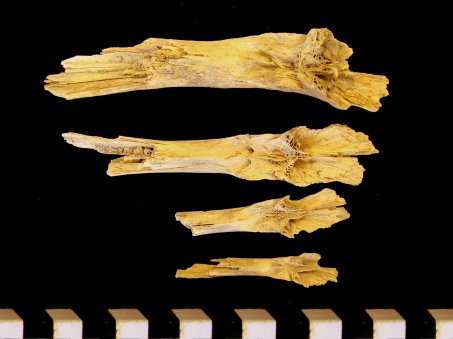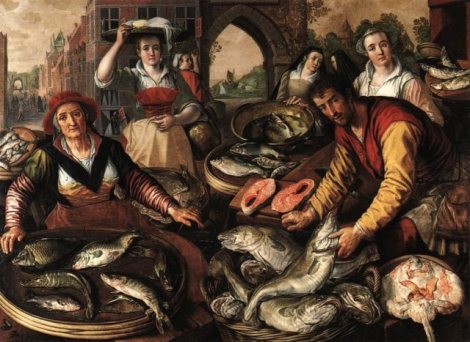I am a zooarchaeologist, but I’m also interested in art. And food. In fact, my research explores why people eat certain things – what is their reason, does eating certain items of food carry meaning, does this reflect their social standing? Specifically, my research has focussed on looking at the changing levels of fish consumption in England.
Great Britain is surrounded by water and yet apart from fish and chips (the fish mainly being cod or haddock), fish do not really form a significant part of the diet. This struck me as being very odd given that I grew up in Brussels where fish and shellfish (alongside chips of course!) are a fundamental part of our diets. In fact for some, like myself, my yearly calendar runs alongside what foods are seasonally available. You have mussels from November to March, small herring called matjes in November or in April after the spawning seasons, cockles in early spring and small brown shrimp most of the year except summer.
Alongside all the real food, I was also surrounded by spectacular paintings that had as their main theme food. Take for instance Joachim Beukelaer’s Four Elements, in which each painting represents one of the elements earth, fire, air or water and this is represented by a market scene. Fish are also an important aspect of still life paintings too, such as “Fish” by Pieter Andreas Rysbrack (1730–1748), York Museums Trust. Many proverbs and sayings are centred around fish and fishing: fishermen’s wives are loud and lewd, catching an eel by the tail is akin to doing an impossible task. Many fish-related proverbs are illustrated in Pieter Brueghel’s Netherlandish Proverbs from the Gemäldegalerie, Berlin– there are plenty of examples to choose from. Having started by studying for a joint honours degree in Art History and Archaeology I came to realise how the research between the two disciplines could be combined.
Many of these paintings have sparked interest in exploring if in the past we ate different species of fish than we do today: were we less picky? I started this adventure for my undergraduate dissertation looking at fish bones from a late Anglo-Saxon site in East Sussex.

. A rather large pile of large cod vertebra recovered from excavations at Bishopstone, East Sussex, a late Anglo-Saxon manor estate.
Looking at the actual bones allows us to get a real idea of who was eating fish and what fish they were eating, a way of adding meat to the bones (or fillet to the skeleton?) of what we see in paintings of the early modern period but also of historical records. The archaeological record of Britain shows that the levels of fishing and fish consumption have changed greatly but we do not yet understand why. Could it be that fish were misunderstood or feared during certain periods? Belief systems encompass everything that is around us, especially our landscapes and environments. By their very nature fish live in an environment that is inhospitable to humans but also one that can become very dangerous suddenly. The mists and fogs of the Fens were renown for harbouring devils, this fog extended to the Channel and often turned to storms that claimed many a life. Creatures that could transcend watery and dry environments like beavers and otters captured the medieval mind. Eels can travel across land from one river to another when it is very wet, this will have added to their mysteriousness but perhaps their appeal.
I followed this first project with my masters and then my PhD, which took a wider approach of looking at fishing and fish consumption in Anglo-Saxon England. In essence I tried to answer six separate questions:
Who is consuming and catching fish?
Where are they catching fish and consuming them?
Why are they consuming fish?
When are they catching and consuming fish?
What fish are they catching?
How are they catching fish?
These questions may seem very simple but in fact are highly complex. This time I wasn’t just counting and identifying fish bones but also looking at the isotope evidence from human bones, material culture associated with fishing such as hooks and sinkers, the location of weirs, place-names but also artistic representations of fish from the Anglo-Saxon period.

Sometimes one doesn’t just find fish bones, instead one finds very old dog poo! This is from a large dog and we can tell they scavenged around the settlement and that their diet consisted of eating discarded bones as the poo was comprised mainly of very small bone fragments.
The result? Well, some people ate fish and others didn’t! More precisely, it seems that people in England started catching and consuming marine fish earlier than we thought, around the late 6th century AD whereas previously it was thought to only have occurred after the 10th century. In addition to this it seems that aristocratic and secular elites may have been the ones who started this new trend. This marked a change in perceptions and understanding of the wilderness, fish seem to become better understood as we move into the 8th century. There is even a possibility that certain fish such as cod may have been caught for their size, perhaps as an activity akin to hunting. Some of the cod bones I found came from fish over a meter long. This is very big in comparison to today’s standard where most cod are only about 50 centimetres long. Catching a big fish out at sea where the weather changes rapidly requires skill and courage. At the same time we also see an increase in the bones of other wild animals at high-status sites.

Parasephenoid, bone central to holding other skull elements together. Here four different sizes are represented, the biggest probably comes from a cod over a metre in length. This is double the size of most modern day caught cod.
However there are still many questions that need answering and exploring. For instance, the impact of fishing on the diet directly needs further exploring. Similarly, fish consumption during the middle ages was very important due to religious fasting rules, could tastes have changed during these years? And could fishing still have been a status symbol? There are plenty more fish in the sea to explore!
Rebecca Reynolds, BA Joint Hons Art History and Archaeology, PhD Archaeology
———
A note about the author:
Rebecca’s PhD is entitled “Food for the Soul: The Socio-economic context of fishing and fish consumption in Anglo-Saxon England, AD 400-1100.” She is currently working as a freelance zooarchaeologist and studying for a Graduate Diploma in Law in order to better understand how we can protect our cultural heritage, whether it is archaeological sites or treasures and artworks.
Email: reynolds.rebecca@gmail.com

Not my area, but makes me wonder about lake, river and shore fish/crustaceans. How far back do they go in Britain as food sources? I guess crabs/shellfish might go all the way back to Neanderthals (any evidence?); but when were the first fish caught? I presume methods might be hard to prove (spears vs hooks). Sorry to go on – just curious…
I believe that we still have traces of fish-traps at coastal sites, and people have made nets for a very long time. Migratory fish — notably salmon, sea-trout, and eels — were abundant until modern times. Oysters have been eaten for centuries, and used to be very cheap. Archaeological evidence for sea-food consumption is plentiful.